Polysiloxane-Based Polyurethanes with High Strength and Recyclability
Abstract
1. Introduction
2. Experimental Section
2.1. Materials
2.2. Synthesis of the HMDI-Based Thermoplastic Polyurethanes
2.3. Characterization
2.3.1. FT-IR Spectroscopy
2.3.2. Gel Permeation Chromatography (GPC)
2.3.3. Differential Scanning Calorimetry (DSC)
2.3.4. Wide-Angle X-ray Diffraction (WAXD)
2.3.5. Small-Angle X-ray Scattering (SAXS)
2.3.6. Atomic Force Microscopy (AFM)
2.3.7. Tensile Testing
2.3.8. Repeatable Processability
3. Results and Discussion
3.1. FT-IR Spectral Analysis
3.2. GPC
3.3. DSC
3.4. WAXD
3.5. SAXS
3.6. AFM
3.7. Mechanical Properties
3.8. Repeatable Processability
4. Conclusions
Supplementary Materials
Author Contributions
Funding
Institutional Review Board Statement
Informed Consent Statement
Data Availability Statement
Conflicts of Interest
References
- Lipomi, D.J.; Bao, Z. Stretcha ble and ultraflexible organic electronics. MRS Bull. 2017, 42, 93–97. [Google Scholar] [CrossRef]
- Zhou, J.; Wang, L.; Li, L.; Feng, S. Novel clickable and fluorescent poly (siloxane amine) s for reusable adhesives and reprocessable elastomers. Polym. Chem. 2020, 11, 4780–4786. [Google Scholar] [CrossRef]
- Hu, H.; Wang, L.; Li, L.; Feng, S. Imine-functionalized polysiloxanes for supramolecular elastomers with tunable mechanical properties. Polym. Chem. 2020, 11, 7721–7728. [Google Scholar] [CrossRef]
- Sun, Z.; Huang, S.; Wu, J.; Zhang, Q. Facile fabrication of superhydrophobic coating based on polysiloxane emulsion. Prog. Org. Coat. 2017, 102, 131–137. [Google Scholar] [CrossRef]
- Cui, Y.; Pan, H.; Zhang, J.; Cao, L.; Zong, C. Influence of polydimethylsiloxane on the microstructure and properties of polyester thermoplastic polyurethane. J. Polym. Res. 2022, 29, 218. [Google Scholar] [CrossRef]
- Zhao, Z.; Ju, P.; Ji, L.; Chen, L.; Wu, Y.; Zhou, H.; Chen, J. Structure optimization of epoxy-functionalized polysiloxanes and tribological properties of the polysiloxane/molybdenum disulfide lubricating coating for low-earth orbit environment. Tribol. Int. 2021, 162, 107135. [Google Scholar] [CrossRef]
- Qiao, M.; Xu, W.; Ji, G.; Zhang, B. Anti-corrosion, anti-bacterial and durable atmospheric weatherability of polydimethylsiloxane coating with intrinsic hydrophobicity. Surf. Topogr. Metrol. Prop. 2022, 10, 025009. [Google Scholar] [CrossRef]
- Dhali, K.; Daver, F.; Cass, P.; Adhikari, B. Surface modification of the cellulose nanocrystals through vinyl silane grafting. Int. J. Biol. Macromol. 2022, 200, 397–408. [Google Scholar] [CrossRef]
- Mihara, S.; Takeok, S. Preparation and characterization of highly elongated polydimethylsiloxane nanosheets. Polym. Advan. Technol. 2022, 33, 1180–1189. [Google Scholar] [CrossRef]
- Meng, Y.; Xu, W.; Newman, M.R.; Benoit, D.S.W.; Anthamatten, M. Thermoreversible siloxane networks: Soft biomaterials with widely tunable viscoelasticity. Adv. Funct. Mater. 2019, 29, 1903721. [Google Scholar] [CrossRef]
- Berahman, R.; Raiati, M.; Mazidi, M.M.; Paran, S.M.R. Preparation and characterization of vulcanized silicone rubber/halloysite nanotube nanocomposites: Effect of matrix hardness and HNT content. Mater. Des. 2016, 104, 333–345. [Google Scholar] [CrossRef]
- Xu, Q.; Pang, M.; Zhu, L.; Zhang, Y.; Feng, S. Mechanical properties of silicone rubber composed of diverse vinyl content silicone gums blending. Mater. Des. 2010, 31, 4083–4087. [Google Scholar] [CrossRef]
- Sun, X.; Chen, R.; Gao, X.; Liu, Q.; Liu, J.; Zhang, H.; Yu, J.; Liu, P.; Takahashi, K.; Wang, J. Fabrication of epoxy modified polysiloxane with enhanced mechanical properties for marine antifouling application. Eur. Polym. J. 2019, 117, 77–85. [Google Scholar] [CrossRef]
- Sirrine, J.M.; Schexnayder, S.A.; Dennis, J.M.; Long, T.E. Urea as a monomer for isocyanate-free synthesis of segmented poly(dimethyl siloxane) polyureas. Polymer 2018, 154, 225–232. [Google Scholar] [CrossRef]
- Fang, P.; Bai, Y.; Wang, W.; Ma, X.; Tai, X.; Wang, G. Properties of ABA and BA polysiloxane amphiphiles modified by polyether. J. Dispers. Sci. Technol. 2018, 39, 1010–1017. [Google Scholar] [CrossRef]
- Xu, C.-A.; Chen, G.; Tan, Z.; Hu, Z.; Qu, Z.; Zhang, Q.; Lu, M.; Wu, K.; Lu, M.; Liang, L. Evaluation of cytotoxicity in vitro and properties of polysiloxane-based polyurethane/lignin elastomers. React. Funct. Polym. 2020, 149, 104514. [Google Scholar] [CrossRef]
- Hu, S.; He, S.; Wang, Y.; Wu, Y.; Shou, T.; Yin, D.; Mu, G.; Zhao, X.; Gao, Y.; Liu, J.; et al. Self-repairable, recyclable and heat-resistant polyurethane for high-performance automobile tires. Nano Energy 2022, 95, 107012. [Google Scholar] [CrossRef]
- Zhao, X.; Fu, G.; Wang, Y.; Wu, Y.; Shou, T.; Yin, D.; Li, X.; Hu, S.; Zhang, L. Bio-based polyurethane/hindered phenol AO-80 composites for room temperature high damping properties. Compos. Part B Eng. 2022, 243, 110118. [Google Scholar] [CrossRef]
- Francolini, I.; Silvestro, I.; di Lisio, V.; Martinelli, A.; Piozziet, A. Synthesis, characterization, and bacterial fouling-resistance properties of polyethylene glycol-grafted polyurethane elastomers. Int. J. Mol. Sci. 2019, 20, 1001. [Google Scholar] [CrossRef] [PubMed]
- Rapone, I.; Taresco, V.; Lisio, V.; Piozzi, A.; Francolini, I. Silver- and Zinc-Decorated Polyurethane Ionomers with Tunable Hard/Soft Phase Segregation. Int. J. Mol. Sci. 2021, 22, 6134. [Google Scholar] [CrossRef] [PubMed]
- Kilic, N.T.; Can, B.N.; Kodal, M.; Özkoç, G. Reactive compatibilization of biodegradable PLA/TPU blends via hybrid nanoparticle. Prog. Rubber Plast. Recycl. Technol. 2021, 37, 301–326. [Google Scholar] [CrossRef]
- Zhu, R.; Wang, X.; Yang, J.; Wang, Y.; Zhang, Z.; Hou, Y.; Lin, F. Influence of hydroxyl-terminated polydimethylsiloxane on high-strength biocompatible polycarbonate urethane films. Biomed. Mater. 2016, 12, 015011. [Google Scholar] [CrossRef]
- Uchida, T.; Kawaguchi, S.; Ito, K. Dispersion (co)polymerization of styrene in polymeric media to prepare polymer micro blends. Des. Monomers Polym. 2002, 5, 285–296. [Google Scholar] [CrossRef]
- Hu, J.; Song, Y.; Ning, N.; Zhang, L.; Yu, B.; Tian, M. An effective strategy for improving the interface adhesion of the immiscible methyl vinyl silicone elastomer/thermoplastic polyurethane blends via developing a hybrid janus particle with amphiphilic brush. Polymer 2021, 214, 123375. [Google Scholar] [CrossRef]
- Gordin, C.; Delaite, C.; Bistac, S.; Schuller, A.S.; Rusu, D.; Rusu, M. PDMS migration at poly (vinyl chloride)/poly (ε-caprolactone)/poly (ε-caprolactone)-b-poly (dimethylsiloxane) blends surfaces. Polym. Test. 2009, 28, 446–451. [Google Scholar] [CrossRef]
- Zhang, Q.; Wu, M. Structure of vinyl polysiloxane on properties of polyacrylates film and its pigment printing application. J. Coat. Technol. Res. 2020, 17, 937–948. [Google Scholar] [CrossRef]
- Zhao, R.; Zhang, Z.; Qi, Y. Influence of Epoxy Content on the Properties and Marine Bacterial Adhesion of Epoxy Modified Silicone Coatings. Coatings 2020, 10, 126. [Google Scholar] [CrossRef]
- Qian, Y.; Dong, F.; Guo, L.; Xu, X.; Liu, H. Two-component waterborne polyurethane modified with terpene derivative-based polysiloxane for coatings via a thiol-ene click reaction. Ind. Crop. Prod. 2021, 171, 113903. [Google Scholar] [CrossRef]
- Zuo, M.; Jiang, Z.; Guo, L.; Dong, F.; Guo, J.; Xu, X. Using α-Pinene-Modified Triethoxysilane as the New Cross-Linking Agent To Improve the Silicone Rubber Properties. ACS Omega 2019, 4, 11921–11927. [Google Scholar] [CrossRef]
- Cui, Y.; Xu, Z.; Li, Y.; Lang, X.; Zong, C.; Cao, L. Synergistic thermodynamic compatibility of polydimethylsiloxane block in thermoplastic polyurethane for flame retardant materials: Super flexible, highly flame retardant and low smoke release. Polymer 2022, 253, 124976. [Google Scholar] [CrossRef]
- Cui, Y.; Pan, H.; Shi, C.; Zhuang, H.; Wang, Q.; Zong, C. A method to essentially increase the compatibility of thermoplastic polyurethane/methyl vinyl silicone rubber based thermoplastic vulcanizate. J. Appl. Polym. Sci. 2022, 139, 52219. [Google Scholar] [CrossRef]
- Cui, Y.; Yan, T.; Pan, H.; Sun, H.; Bai, X.; Cao, L.; Zong, C. Preparation and Characterization of Intrinsically Compatibilized Thermoplastic Polyurethane and Silicone Rubber. Macromol. Chem. Phys. 2022, 223, 2270018. [Google Scholar] [CrossRef]
- Vale, M.; Mateus, M.M.; Santos, R.G.d.; de Castro, C.N.; de Schrijver, A. Replacement of petroleum-derived diols by sustainable biopolyols in one component polyurethane foams. J. Clean. Prod. 2019, 212, 1036–1043. [Google Scholar] [CrossRef]
- Cefarin, N.; Bedolla, D.E.; Surowka, A.; Donato, S.; Sepperer, T.; Tondi, G.; Dreossi, D.; Sodini, N.; Birarda, G.; Vaccari, L. Study of the Spatio-Chemical Heterogeneity of Tannin-Furanic Foams: From 1D FTIR Spectroscopy to 3D FTIR Micro-Computed Tomography. Int. J. Mol. Sci. 2021, 22, 12869. [Google Scholar] [CrossRef]
- Liu, F.; Chen, S. The Preparation and Characterization of Polyurethane Foam with Coconut Oil Polyol and Rapeseed Oil Polyol. J. Polym. Environ. 2021, 29, 2421–2434. [Google Scholar] [CrossRef]
- Yang, W.; Han, Y.; Zhang, W.; Zhang, D. High-Strength and Low-Cost Biobased Polyurethane Foam Composites Enhanced by Poplar Wood Powder Liquefaction. Polymers 2021, 13, 2999. [Google Scholar] [CrossRef]
- Kucinska-Lipka, J.; Gubanska, I.; Strankowski, M.; Cieśliński, H.; Filipowicz, N.; Janik, H. Synthesis and characterization of cycloaliphatic hydrophilic polyurethanes, modified with l -ascorbic acid, as materials for soft tissue regeneration. Mater. Sci. Eng. C 2017, 75, 671–681. [Google Scholar] [CrossRef]
- Lei, W.; Sun, Y.; Huang, B.; Zhou, X. Synthesis and Application of Polyurethane-Modified Silicone as Finishing Agent for Cotton Fabric. Fibers Polym. 2018, 19, 1024–1031. [Google Scholar] [CrossRef]
- Sharma, S.; Mandhani, A.; Bose, S.; Basu, B. Dynamically crosslinked polydimethylsiloxane-based polyurethanes with contact-killing antimicrobial properties as implantable alloplasts for urological reconstruction. Acta Biomater. 2021, 129, 122–137. [Google Scholar] [CrossRef]
- Al Kayal, T.; Losi, P.; Asaro, M.; Volpi, S.; Bonani, W.; Bonini, M.; Soldani, G. Analysis of oxidative degradation and calcification behavior of a silicone polycarbonate polyurethane-polydimethylsiloxane material. J. Biomed. Mater. Res. Part A 2022, 110, 1109–1120. [Google Scholar] [CrossRef]
- Noreen, A.; Zia, K.M.; Tabasum, S.; Aftab, W.; Shahid, M.; Zuber, M. Structural elucidation and biological aptitude of modified hydroxyethylcellulose-polydimethyl siloxane based polyurethanes. Int. J. Biol. Macromol. 2020, 150, 426–440. [Google Scholar] [CrossRef] [PubMed]
- Dores, A.P.D.; Llorente, O.; Martin, L.; González, A.; Irusta, L. Polydimethylsiloxane containing waterborne hydrophobic polyurethane coatings with good adhesion to metals: Synthesis and characterization. Prog. Org. Coat. 2022, 162, 106564. [Google Scholar] [CrossRef]
- Galhenage, T.P.; Hoffman, D.; Silbert, S.D.; Stafslien, S.J.; Daniels, J.; Miljkovic, T.; Finlay, J.A.; Franco, S.C.; Clare, A.S.; Nedved, B.; et al. Fouling-Release Performance of Silicone Oil-Modified Siloxane-Polyurethane Coatings. ACS Appl. Mater. Interfaces 2016, 8, 29025–29036. [Google Scholar] [CrossRef] [PubMed]
- Galhenage, T.P.; Stafslien, S.J.; Skaja, A.; Webster, D.C. Durable siloxane-polyurethane coatings for mitigating freshwater mussel fouling. Biofouling 2022, 38, 260–270. [Google Scholar] [CrossRef]
- Kim, M.G.; Jo, K.I.; Kim, E.; Park, J.H.; Ko, J.W.; Lee, J.H. Preparation of Polydimethylsiloxane-Modified Waterborne Polyurethane Coatings for Marine Applications. Polymers 2021, 13, 4283. [Google Scholar] [CrossRef]
- Hu, S.; Wu, Y.; Fu, G.; Shou, T.; Zhai, M.; Yin, D.; Zhao, X. Bio-Based Polyurethane and Its Composites towards High Damping Properties. Int. J. Mol. Sci. 2022, 23, 6618. [Google Scholar] [CrossRef]
- Byrne, C.A.; Mack, D.P.; Sloan, J.M. A Study of Aliphatic Polyurethane Elastomers Prepared from Diisocyanate Isomer Mixtures. Rubber Chem. Technol. 1985, 58, 985–996. [Google Scholar] [CrossRef]
- Lee, D.-K.; Tsai, H.-B. Properties of segmented polyurethanes derived from different diisocyanates. J. Appl. Polym. Sci. 2000, 75, 167–174. [Google Scholar] [CrossRef]
- Cheng, Q.; Zheng, Y.; Wang, T.; Sun, D.; Lin, R. Yellow resistant photosensitive resin for digital light processing 3D printing. J. Appl. Polym. Sci. 2020, 137, 48369. [Google Scholar] [CrossRef]
- Wang, W.; Sun, S.; Hu, S.; Yang, B.; He, S.; Wang, R.; Zhang, L. Unprecedented Strength Polysiloxane-Based Polyurethane for 3D Printing and Shape Memory. ACS Appl. Mater. Interfaces 2022, 14, 3324–3333. [Google Scholar] [CrossRef]
- Sun, N.; Di, M.; Liu, Y. Lignin-containing polyurethane elastomers with enhanced mechanical properties via hydrogen bond interactions. Int. J. Biol. Macromol. 2021, 184, 1–8. [Google Scholar] [CrossRef]
- Xu, C.-A.; Qu, Z.; Tan, Z.; Nan, B.; Meng, H.; Wu, K.; Shi, J.; Lu, M.; Liang, L. High-temperature resistance and hydrophobic polysiloxane-based polyurethane films with cross-linked structure prepared by the sol-gel process. Polym. Test. 2020, 86, 106485. [Google Scholar] [CrossRef]
- Hu, S.; Shou, T.; Fu, G.; Zhao, X.; Wang, Z.; Zhang, L. New Stratagem for Designing High-Performance Thermoplastic Polyurethane by Using a New Chain Extender. Macromol. Chem. Phys. 2021, 222, 2000439. [Google Scholar] [CrossRef]
- Kong, Z.; Tian, Q.; Zhang, R.; Yin, J.; Shi, L.; Bin Ying, W.; Hu, H.; Yao, C.; Wang, K.; Zhu, J. Reexamination of the microphase separation in MDI and PTMG based polyurethane: Fast and continuous association/dissociation processes of hydrogen bonding. Polymer 2019, 185, 121943. [Google Scholar] [CrossRef]
- Choi, T.; Weksler, J.; Padsalgikar, A.; Runt, J. Microstructural organization of polydimethylsiloxane soft segment polyurethanes derived from a single macrodiol. Polymer 2010, 51, 4375–4382. [Google Scholar] [CrossRef]
- Hernandez, R.; Weksler, J.; Padsalgikar, A.; Runt, J. Microstructural Organization of Three-Phase Polydimethylsiloxane-Based Segmented Polyurethanes. Macromolecules 2007, 40, 5441–5449. [Google Scholar] [CrossRef]
- Hu, S.; Shou, T.; Zhao, X.; Wang, Z.; Zhang, S.; Qin, X.; Guo, M.; Zhang, L. Rational design of a novel NDI-based thermoplastic polyurethane elastomer with superior heat resistance. Polymer 2020, 205, 122764. [Google Scholar] [CrossRef]
- Tang, L.; Shao, S.; Wang, A.; Tian, C.; Luo, F.; Li, J.; Li, Z.; Tan, H.; Zhang, H. Influence of fluorocarbon side chain on microphase separation and chemical stability of silicon-containing polycarbonate urethane. Polymer 2022, 242, 124538. [Google Scholar] [CrossRef]
- Wang, F.; Chen, S.; Wu, Q.; Zhang, R.; Sun, P. Strain-induced structural and dynamic changes in segmented polyurethane elastomers. Polymer 2019, 163, 154–161. [Google Scholar] [CrossRef]
- Xu, C.; Ding, S.; Liu, X.; Wang, F.; Shi, Y.; Wang, X.; Wang, Z. Superhigh strength polyurethane materials with oriented microdomains produced through mechanical deformation. Polymer 2022, 253, 124968. [Google Scholar] [CrossRef]



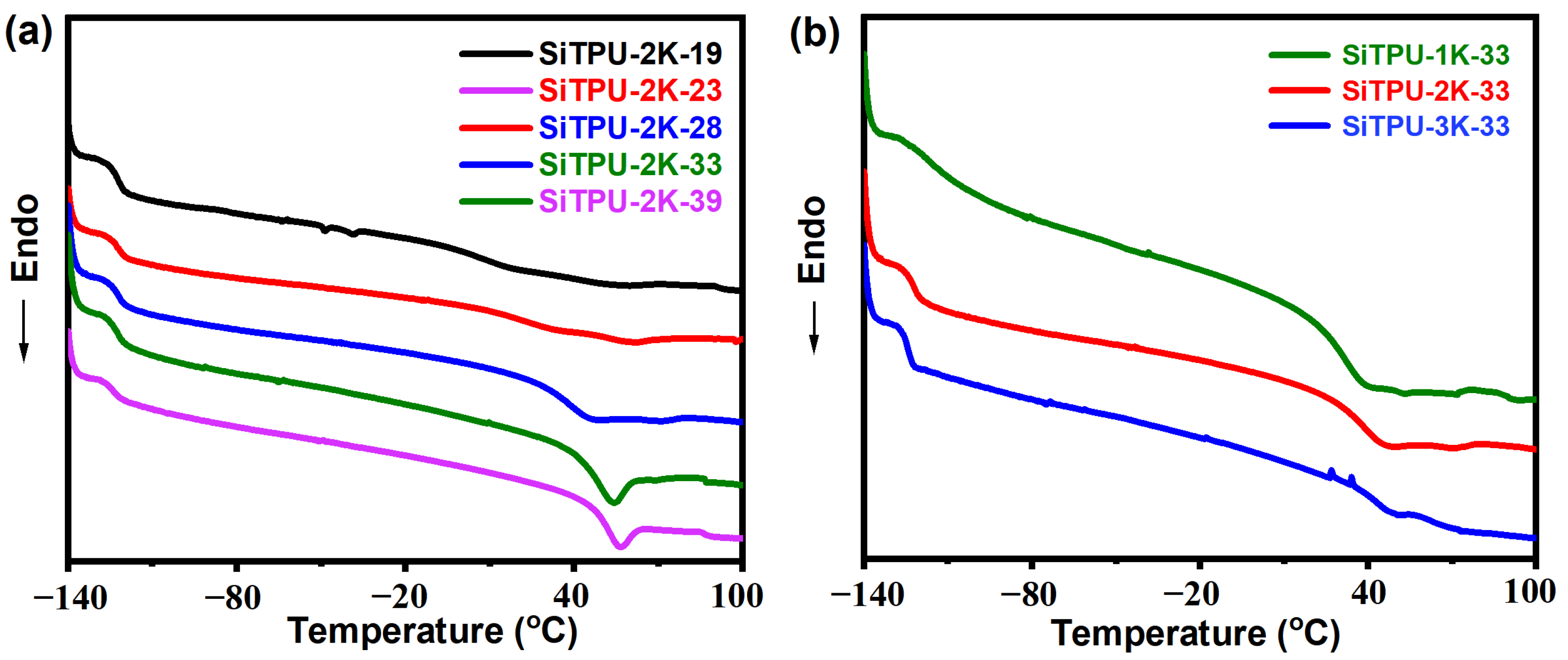
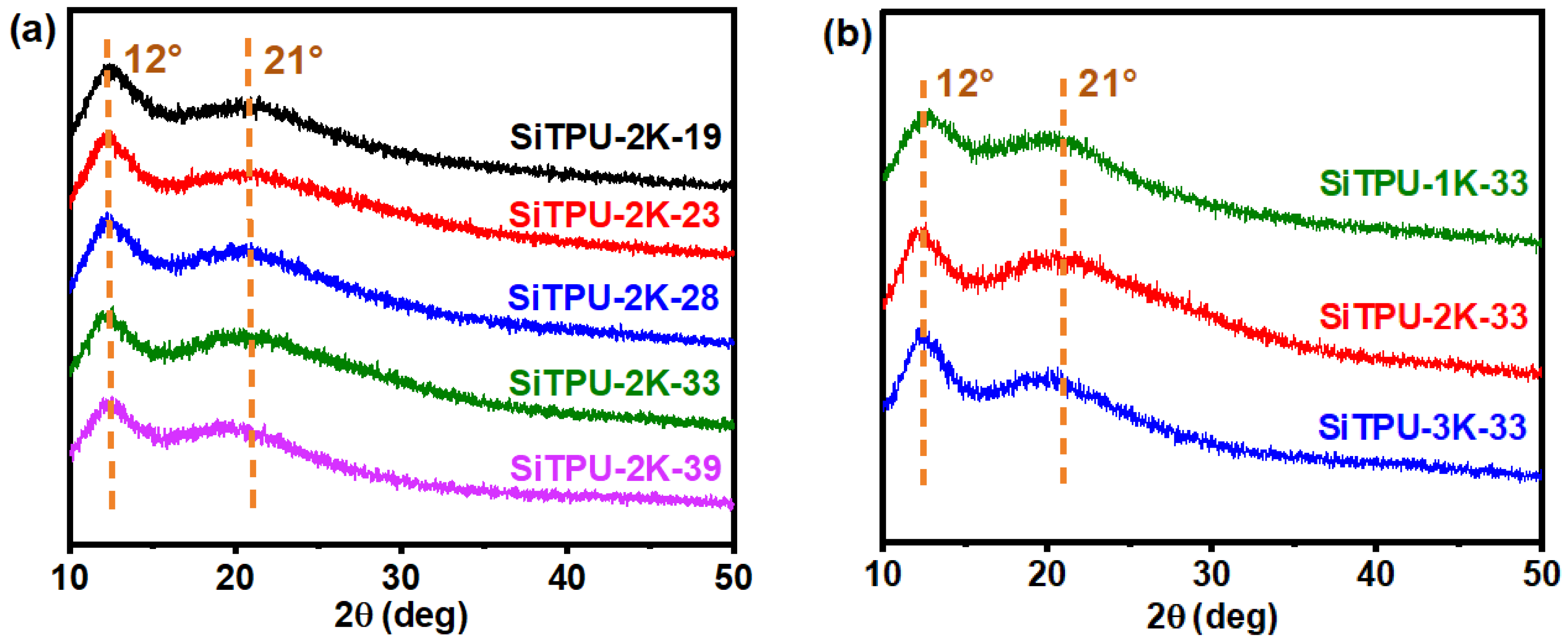

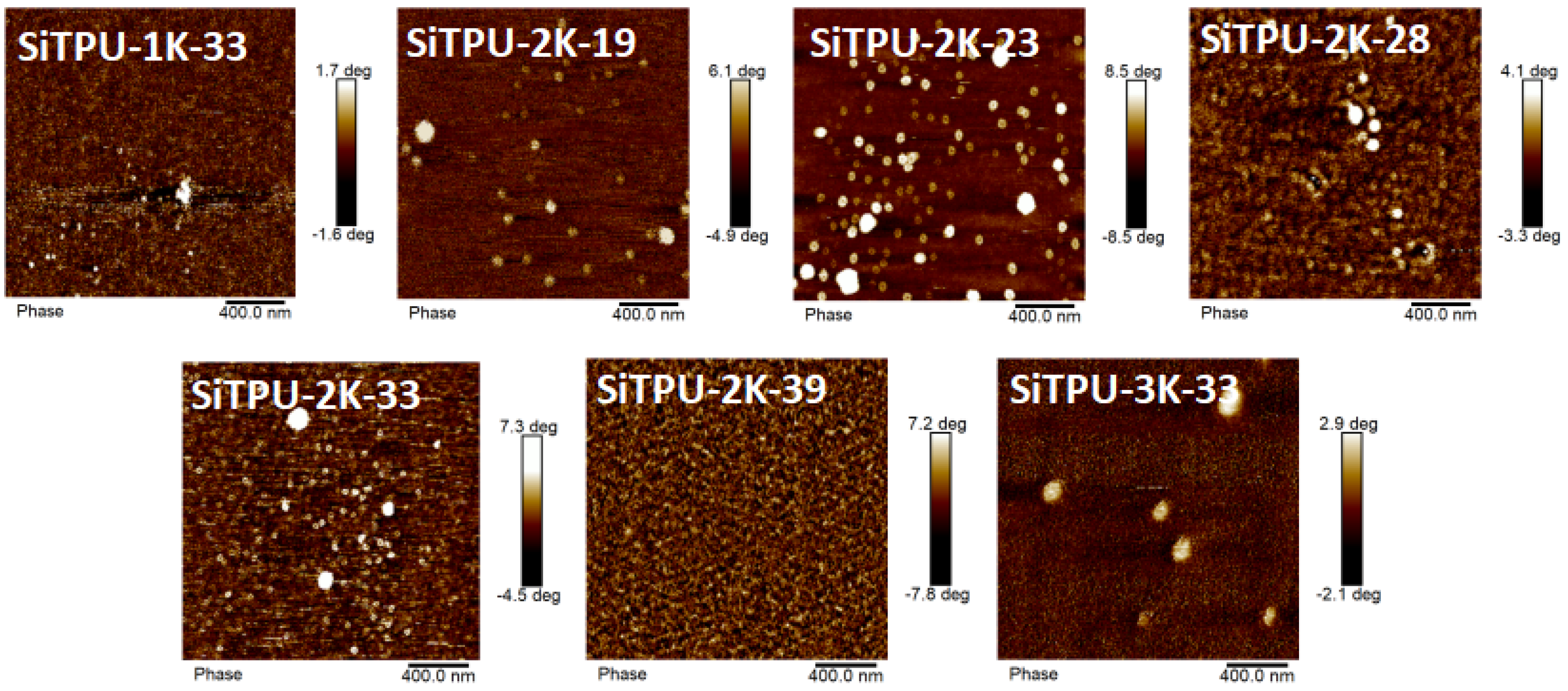

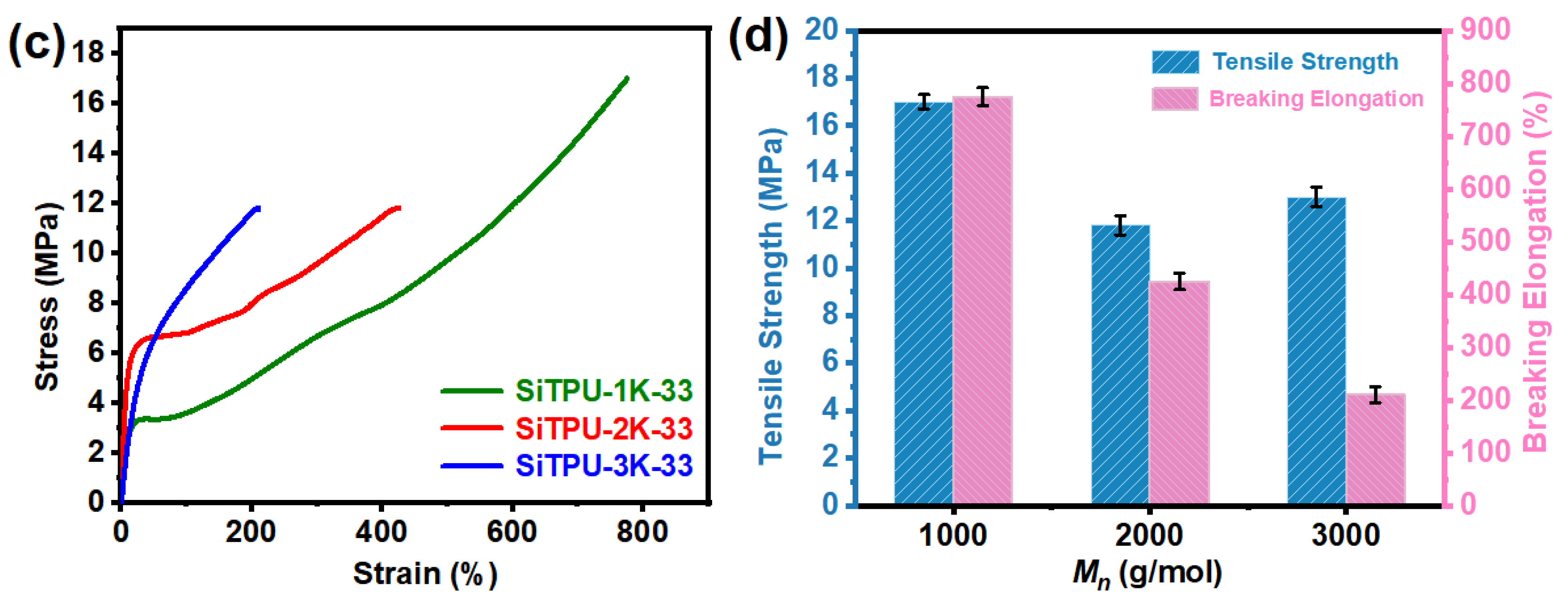
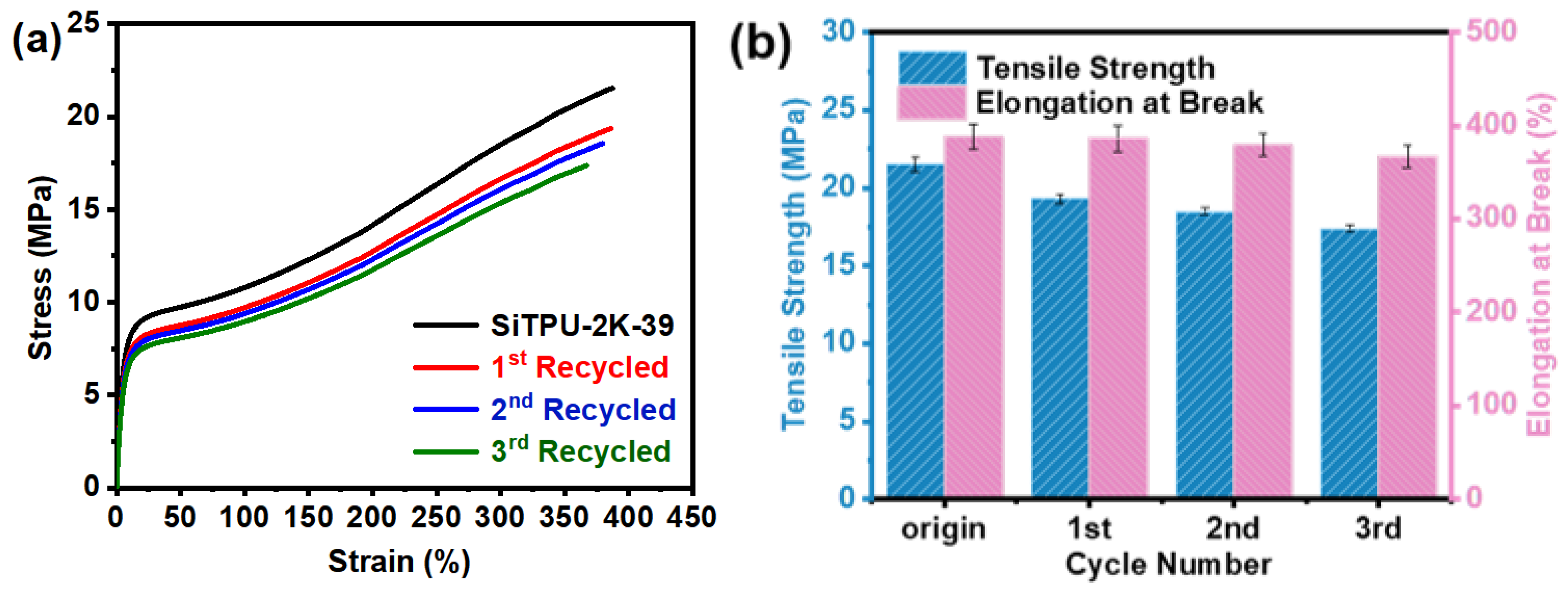
| Sample | SS Mn | HS Content | PDMS:HMDI:BDO (Molar Ratio) |
|---|---|---|---|
| SiTPU-1K-33 | 1000 | 33% | 1:1.15:0.15 |
| SiTPU-2K-19 | 2000 | 19% | 1:1.1:0.1 |
| SiTPU-2K-23 | 2000 | 23% | 1:1.45:0.45 |
| SiTPU-2K-28 | 2000 | 28% | 1:2:1 |
| SiTPU-2K-33 | 2000 | 33% | 1:2.5:1.5 |
| SiTPU-2K-39 | 2000 | 39% | 1:3.4:2.4 |
| SiTPU-3K-33 | 3000 | 33% | 1:4:3 |
| Sample | Hydrogen-Bonded Carbonyls (1699 cm−1) | Free Carbonyls (1726 cm−1) |
|---|---|---|
| SiTPU-1K-33 | 81.37 | 18.63 |
| SiTPU-2K-19 | 77.30 | 22.70 |
| SiTPU-2K-23 | 77.96 | 22.04 |
| SiTPU-2K-28 | 78.50 | 21.50 |
| SiTPU-2K-33 | 80.85 | 19.15 |
| SiTPU-2K-39 | 83.82 | 16.18 |
| SiTPU-3K-33 | 79.21 | 20.79 |
Publisher’s Note: MDPI stays neutral with regard to jurisdictional claims in published maps and institutional affiliations. |
© 2022 by the authors. Licensee MDPI, Basel, Switzerland. This article is an open access article distributed under the terms and conditions of the Creative Commons Attribution (CC BY) license (https://creativecommons.org/licenses/by/4.0/).
Share and Cite
Wang, W.; Bai, X.; Sun, S.; Gao, Y.; Li, F.; Hu, S. Polysiloxane-Based Polyurethanes with High Strength and Recyclability. Int. J. Mol. Sci. 2022, 23, 12613. https://doi.org/10.3390/ijms232012613
Wang W, Bai X, Sun S, Gao Y, Li F, Hu S. Polysiloxane-Based Polyurethanes with High Strength and Recyclability. International Journal of Molecular Sciences. 2022; 23(20):12613. https://doi.org/10.3390/ijms232012613
Chicago/Turabian StyleWang, Wencai, Xueyang Bai, Siao Sun, Yangyang Gao, Fanzhu Li, and Shikai Hu. 2022. "Polysiloxane-Based Polyurethanes with High Strength and Recyclability" International Journal of Molecular Sciences 23, no. 20: 12613. https://doi.org/10.3390/ijms232012613
APA StyleWang, W., Bai, X., Sun, S., Gao, Y., Li, F., & Hu, S. (2022). Polysiloxane-Based Polyurethanes with High Strength and Recyclability. International Journal of Molecular Sciences, 23(20), 12613. https://doi.org/10.3390/ijms232012613








